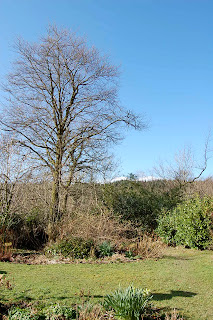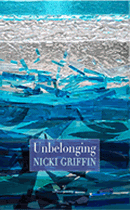 When I look out of the bedroom window there appears to be a minor earthquake in the Haggard - the water in the pond is swilling about even though there's no wind. There are waves and swirls and wide wide ripples.
When I look out of the bedroom window there appears to be a minor earthquake in the Haggard - the water in the pond is swilling about even though there's no wind. There are waves and swirls and wide wide ripples.It's the frogs, of course, and this is very mild activity to what will come over the next couple of weeks as the head count goes up (literally - that's all you can see of them from a distance) and efforts to mate become more frantic. From the courtyard there is a steady purring sound, rhythmic, soothing. If you manage to get close up without the frogs diving for cover you can see the cheeks of the males puffing out as they produce this astonishing, endless sound.

 Other spring activities - we've been cutting things back. Joe has been busy with the chainsaw over the last few weeks, cutting down a few ash trees for fuel. They'll grow again of course, ready for another cut in seven or eight years time. And yesterday we had a couple of tree cutting men up to take down a full-grown sycamore. Joe has been talking about knocking this one for a while, but I resisted. It's a mature tree, standing proud beside the beautiful copper beech in the Grove.
Other spring activities - we've been cutting things back. Joe has been busy with the chainsaw over the last few weeks, cutting down a few ash trees for fuel. They'll grow again of course, ready for another cut in seven or eight years time. And yesterday we had a couple of tree cutting men up to take down a full-grown sycamore. Joe has been talking about knocking this one for a while, but I resisted. It's a mature tree, standing proud beside the beautiful copper beech in the Grove.It's what I look out at from my kitchen window, and have thought of it as one of two guardians. However, I finally came round to the idea over the winter months. It blocked a lot of light, it's 'only' a sycamore (not a native tree) and it gets black spot on its leaves in late summer every year. Beyond is another copper beech, the growth of which is limited by this sycamore. In summer it blocks the late evening sunlight. We would be lit up for much longer on the terrace and in the kitchen if it wasn't there.
So down it came. I couldn't look at first, felt guilty, saw the branches had been full of lichen - the beardy type that only grows in places without air pollution. On the walk afterwards I became obsessed with looking for trees with this bearded lichen, then Googled it. The Latin name is Usnea, and it has many uses I hadn't realised. It's a medicinal plant, having antibiotic and antifungal qualities - it was useful for treating wounds before the days of antibiotics, its hairlike fibres acting as a form of gauze.
We do have other lichened trees - the old apples in the Haggard and the oaks bordering the field beyond. There are others on the surrounding land and up the road towards Jones's.
I've also done some planting. One of the men who came to cut the tree has a small nursery on the other side of Tuamgraney, and just before he left he offered me a bunch of bare-rooted whitethorns. That morning I'd been thinking about getting some whitethorns for the 'hedge' I'm growing along the fence that runs along the Rough Side. I knew I hadn't much time left - bare-rooted stock has to go in before the end of February (or thereabouts) while the plants are still dormant. I probably wouldn't have got round to it. So in they went. Eleven new native trees. Guilt lessened. A bit.

















